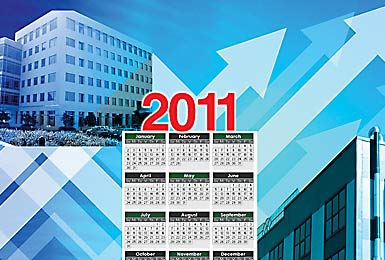Commercial Real Estate 2011: Opportunity Returns
With corporations earning record profits and lease deals still available, opportunity and growth will return to the commercial real estate sector in 2011.
2011 Directory

To some extent, keys have been returned on many buildings, available sub-lease space has been plentiful, and real estate portfolios have been consolidated almost non-stop since 2008. But the hysteria and impending sense of doom has ended. So what happened? Is the end as near as we once thought?
In short, that's not likely. Instead, we have found a new normal in commercial real estate that is not nearly as severe as predicted.
The New Normal
But why? For starters, deals still happen in a recession. Leases expire and are renewed. Landlords have dropped rental rates and added free rent and major work letter concessions. Buildings age and need maintenance, and companies move to more modern or efficient facilities to accommodate changes in business practices and technology. Many states and municipalities pushed business incentives when possible to business retention policies to aid strategic projects.
At this time last year there were very few toes in the water. A bleak 2009 rolled into a 2010 that felt of great malaise (to borrow a term from our last recession) mixed with high unemployment, impending inflation, and low consumer confidence. In 2010, people looked around, but barely outside of, the most pressing and immediate needs within their portfolios.
But 2011 has a different feel. Caution still characterizes the real estate market, but now it seems that there are enough toes in the water that the pool is getting crowded. Things are more positive than many perceive, and competition for space is returning in some instances.
Driving Recovery
Companies are sitting on significant piles of cash, a positive note. Retooling, new operations, and business expansions have been on hold for the last three years. Cost management and headcount reductions - not new market opportunities - have led profits and cost savings over the past several quarters. But now people are getting off of the sidelines partly because they must, as leases expire and machines and buildings require maintenance. The trend is also due to company cost controls that have reached their limits in many budgets. For many companies operating with skeleton crews, budgets can't be trimmed any further.
Mergers and acquisitions activity is gaining traction as executives use acquisition of new businesses as a leading way to grow the bottom line. With valuations down and money still relatively inexpensive, M&A activity will likely drive 2011 real estate transactions. How does that affect the real estate market? Consolidations. As companies are put together and pulled apart, redundancies must be eliminated to justify purchase costs to shareholders, driving transactions at a minimum. Cherry picking facilities within combined portfolios is a major activity, and acquiring additional space or retrofitting and rebuilding at those sites is driving many site selection decisions.
Lower cost real estate alternatives within the portfolio, if they have not already been utilized, will remain a key factor in lessening operating costs. Relocations to cost effective locations also generate activity. This still drives the expansion of manufacturing activities in the Southeast and Southwest.
Project Announcements
Canfor Expands Fulton, Alabama, Production Operations
04/22/2024
Tucker Door & Trim Plans Henrico County, Virginia, Operations
04/19/2024
Zekelman Industries Expands Blytheville, Arkansas, Operations
04/19/2024
Fibrebond Corporation Expands Webster Parish, Louisiana, Operations
04/19/2024
Master Steel Expands Hardeeville, South Carolina, Operations
04/19/2024
L3Harris Technologies Expands Orange County, Virginia, Operations
04/18/2024
Most Read
-
2023's Leading Metro Locations: Hotspots of Economic Growth
Q4 2023
-
2023 Top States for Doing Business Meet the Needs of Site Selectors
Q3 2023
-
38th Annual Corporate Survey: Are Unrealized Predictions of an Economic Slump Leading Small to Mid-Size Companies to Put Off Expansion Plans?
Q1 2024
-
Making Hybrid More Human in 2024
Q1 2024
-
Manufacturing Momentum Is Building
Q1 2024
-
20th Annual Consultants Survey: Clients Prioritize Access to Skilled Labor, Responsive State & Local Government
Q1 2024
-
Public-Private Partnerships Incentivize Industrial Development
Q1 2024
